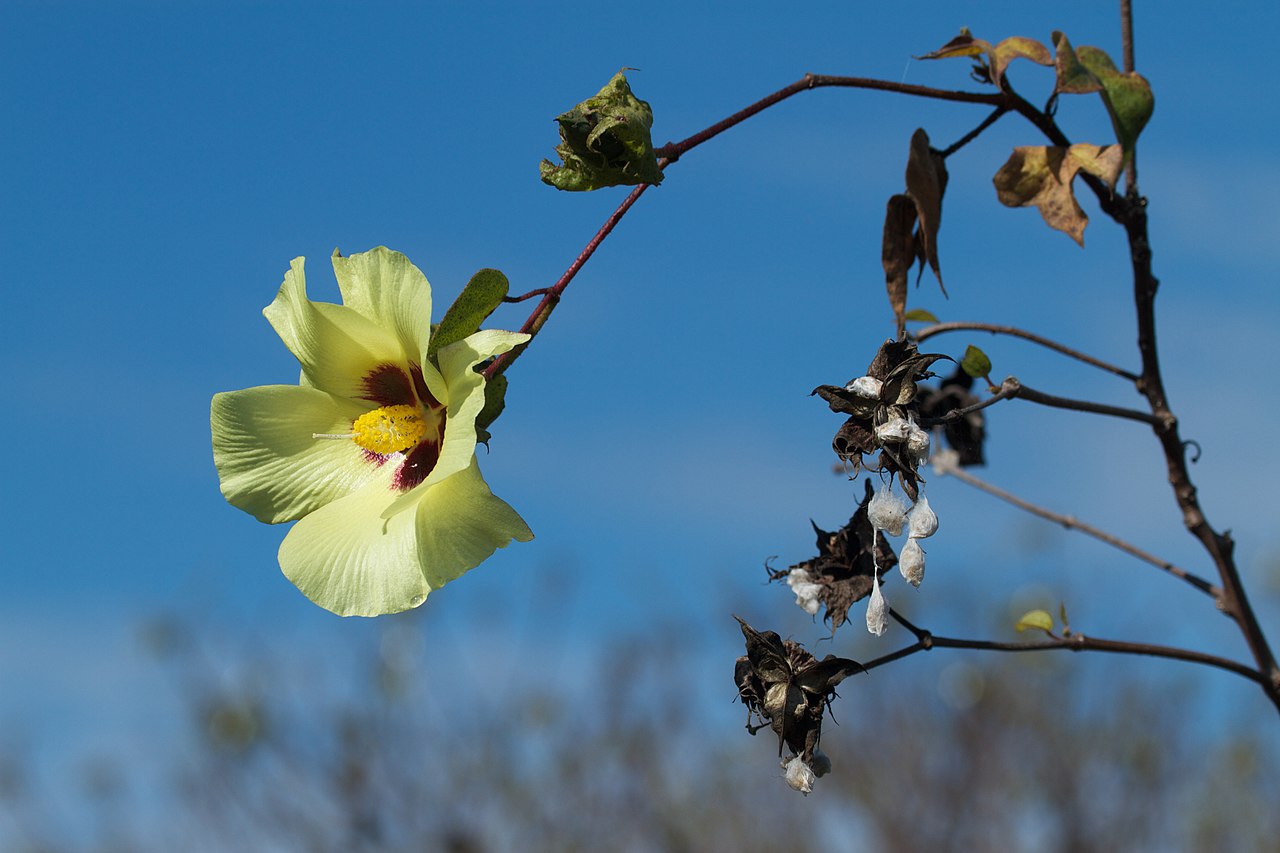Gossypium barbadense

|
|
Gossypium barbadense Common Names: West Indian Cotton, Sea Island Cotton,
Pima Cotton, Egyptian Cotton, Extra-Long Staple (ELS) Cotton Scientific
Classification Kingdom: Plantae Clade: Tracheophytes Clade: Angiosperms Clade: Eudicots Clade: Rosids Order: Malvales Family: Malvaceae Genus: Gossypium Subgenus: G. subg. Karpas Species: G. barbadense Synonyms: Gossypium vitifolium Lam., Gossypium evertum J.B.S.Norton, Gossypium peruvianum Cav., Gossypium brasiliense Macfad. Morphological Description Gossypium barbadense is a tropical, frost-sensitive perennial shrub or small
tree, typically growing 2–3 meters tall, though it can reach 6 meters in
traditional systems. Its key morphological features include: · Stems: Woody, erect, branching, with a smooth to slightly pubescent
texture. · Leaves: Broad, dark green, palmately lobed (3–5 lobes), 7–15 cm long
and wide, with a slightly hairy undersurface. · Flowers: Yellow with a purple or red center, 5–7 cm across, borne
singly or in small clusters; petals five, obovate. · Fruit: A boll, ovoid, 3–5 cm long, green when immature, splitting
open at maturity to reveal black seeds enveloped in long, white, silky fibers
(staple length 34–42 mm). The plant’s tetraploid
genome (52 chromosomes) distinguishes it within the subgenus Karpas,
contributing to its superior fiber quality (Weakley, 2015). Distribution and Habitat Gossypium barbadense originated in southwest Ecuador and northwest Peru, likely
domesticated by pre-Columbian cultures. It is now cultivated globally in
tropical and subtropical regions, including: · Americas: Peru, United States (California, Texas, Arizona), Barbados,
Brazil (annual rainfall 750–1,500 mm). · Africa: Egypt, Sudan, Nigeria (altitude 0–1,200 m). · Asia: India, China, Uzbekistan. · Oceania: Australia. It thrives in warm
climates (20–30°C), requiring full sun and well-drained, fertile soils (pH
6.0–7.5). Its frost sensitivity limits cultivation to frost-free zones (Porcher
& Fick, 2005). Ethnopharmacology Gossypium barbadense has a rich history in traditional medicine, primarily
utilizing seeds, roots, and leaves rather than fibers: · Antihypertensive: In Peru, root decoctions treat high blood
pressure. Rojas et al. (2009) noted its use among Andean communities, though
clinical validation is pending. · Analgesic: Seed oil is applied for headaches in West Africa. · Antimicrobial: Leaf extracts combat infections in Brazil(De Lima et al.1997). · Antiprotozoal: Seeds treat malaria in Nigeria (De Lima et al.1997). · Gastrointestinal: Root infusions aid dysentery and abdominal
cramps in South America. Hammond et al. (1997) documented its ethnobotanical
use in Bolivia. ⚠ Toxicity Profile: Gossypium barbadense seeds contain gossypol, a polyphenolic
toxin causing nausea, fatigue, and liver damage at high doses (>1
mg/kg/day). Acute toxicity in rats (>500 mg/kg) includes cardiac
irregularities. Pregnant women and livestock are particularly vulnerable;
traditional use requires careful dosing (Dodou, 2005). Additional Uses · Textile: Produces extra-long staple fibers (34–42 mm), ideal for
luxury fabrics like Pima and Egyptian cotton, prized for softness and
durability (Porcher & Fick, 2005). · Agricultural: Cottonseed oil and meal serve as livestock feed, though
gossypol content reduces appeal compared to G. hirsutum (Weakley, 2015). · Cultural: Historically significant in Sea Island plantations; fibers
were a luxury export by the 18th century (Porcher & Fick, 2005). References
External Links More Pictures |
|
| Compounds of Gossypium barbadense | |
| References |